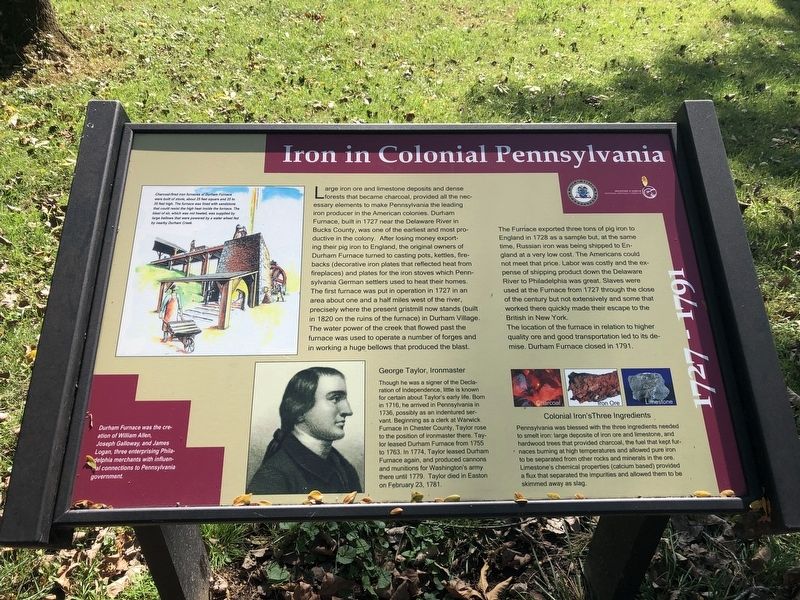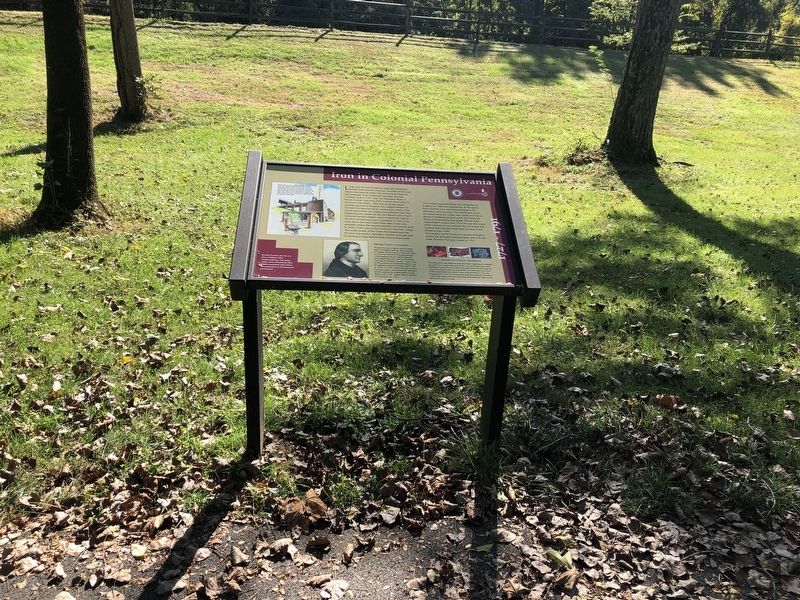Easton in Northampton County, Pennsylvania — The American Northeast (Mid-Atlantic)
Iron in Colonial Pennsylvania
1727 - 1791
Large iron ore and limestone deposits and dense forests that became charcoal, provided all the necessary elements to make Pennsylvania the leading iron producer in the American colonies. Durham Furnace, built in 1727 near the Delaware River in Bucks County, was one of the earliest and most productive in the colony. After losing money exporting their pig iron to England, the original owners of Durham Furnace turned to casting pots, kettles, firebacks (decorative iron plates that reflected heat from fireplaces) and plates for the iron stoves which Pennsylvania German settlers used to heat their homes. The first furnace was put in operation in 1727 in an area about one and a half miles west of the river, precisely where the present gristmill now stands (built in 1820 on the ruins of the furnace) in Durham Village. The water power of the creek that flowed past the furnace was used to operate a number of forgest and in working a huge bellows that produced the blast.
The Furnace exported three tons of pig iron to England in 1728 as a sample but, at the time, Russian iron was being shipped to England at a very low cost. The American could not meet that price. Labor was costly and the expense of shipping product down the Delaware River to Philadelphia was great. Slaves were used at the Furnace from 1727 through the close of the century but not extensively and some that worked there quickly made their escape to the British in New York.
The location of the furnace in relation to higher quality ore and good transportation led to its demise. Durham Furnace closed in 1791.
[Sidebar and captions:]
Charcoal-fired iron furnaces at Durham Furnace were built of stone, about 25 feet square ant 25 to 35 feet high. The furnace was lined with sandstone that could resist the high heat inside the furnace. The blast of air, which was not heated, was supplied by large bellows that were powered by a water wheel fed by nearby Durham Creek.
Durham Furnace was the creation of William Allen, Joseph Galloway, and James Logan, three enterprising Philadelphia merchants with influential connections to Pennsylvania government.
George Taylor, Ironmaster
Though he was a signer of the Declaration of Independence, little is known for certain about Taylor's early life. Born in 1716, he arrived in Pennsylvania in 1736, possibly as an indentured servant. Beginning as a clerk at Warwick Furnace in Chester County, Taylor rose to the position of ironmaster there. Taylor leased Durham Furnace from 1755 to 1763. In 1774, Taylor leased Durham Furnace again, and produced cannons and munitions for Washington's army there until 1779. Taylor died in Easton on February
Colonial Iron's Three Ingredients
Pennsylvania was blessed with the three ingredients needed to smelt iron: large deposite of iron ore and limestone, and hardwood trees that provided charcoal, the fuel that kept furnaces burning at high temperatures and allowed pure iron to be separated from the other rocks and minerals in the ore. Limestone's chemical properties (calcium based) provided a flux that separated the impurities and allowed them to be skimmed away as slag.
Erected by City of Easton, Pennsylvania.
Topics and series. This historical marker is listed in these topic lists: African Americans • Colonial Era • Industry & Commerce • Natural Resources. In addition, it is included in the Signers of the Declaration of Independence series list. A significant historical date for this entry is February 23, 1781.
Location. 40° 40.126′ N, 75° 14.193′ W. Marker is in Easton, Pennsylvania, in Northampton County. Marker is on Hugh Moore Park Road, 0.1 miles south of Hill Road, on the left when traveling south. Touch for map. Marker is in this post office area: Easton PA 18042, United States of America. Touch for directions.
Other nearby markers. At least 8 other markers are within walking distance of this marker. Men of Iron (a few steps from this marker); From Brownfields to Greenfields (a few steps from this marker); Birthplace of the American Industrial Revolution (a few steps from this marker); The Industrial Revolution (within shouting distance of this marker); Fathers of the Industrial Revolution (within shouting distance of this marker); Hugh Moore Park (within shouting distance of this marker); The Promise of Anthracite Coal (about 300 feet away, measured in a direct line); Lehigh Crane Iron Company (about 400 feet away). Touch for a list and map of all markers in Easton.
Additional keywords. slave labor
Credits. This page was last revised on October 5, 2020. It was originally submitted on October 5, 2020, by Devry Becker Jones of Washington, District of Columbia. This page has been viewed 206 times since then and 38 times this year. Photos: 1, 2. submitted on October 5, 2020, by Devry Becker Jones of Washington, District of Columbia.

